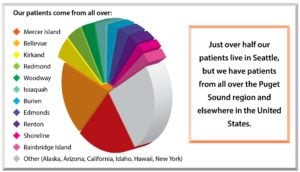After nearly 14 years in operation, we’ve accumulated some statistics …
that may be of interest. Health statistics are one, but obviously an imperfect, measure of health care quality. In sharing some of our data, I would point out that physicians practicing in large healthcare systems often find their job performance, and sometimes their paycheck, depends on meeting certain “quality metrics” such as how many diabetics have blood sugar well controlled or how many patients received a colonoscopy. Remember that every patient is different. You want your physician advocating for you, not for the bean counters. Still, to completely ignore health statics and outcome data is probably unwise.
We currently have 404 patients. A good measure of quality in a concierge practice is whether or not patients stick around. It is much easier to vote with your feet when you’re cared for under the concierge model. The turnover in large primary care practices is considerable. Some estimates put it at 30% per year. Patient turnover is only part of the problem. Nationwide, physician turnover is about 7% per year, which means that in any given year, there is a lot of patients and physicians breaking off established relationships. This is not good health care.
 In contrast, our practice is quite stable. About 95% of our patients have been here 5 years or longer, and more than half have been here 8-14 years. In any given year, <1% of the practice leaves because they are dissatisfied with the care provided. We have a broad distribution of ages, with the majority of patients between 40 and 79, but we have the full gamut from teenagers to folks in their nineties. Sixty percent are from Seattle and the remaining 40% are on the East side or scattered in places like New York or California.
In contrast, our practice is quite stable. About 95% of our patients have been here 5 years or longer, and more than half have been here 8-14 years. In any given year, <1% of the practice leaves because they are dissatisfied with the care provided. We have a broad distribution of ages, with the majority of patients between 40 and 79, but we have the full gamut from teenagers to folks in their nineties. Sixty percent are from Seattle and the remaining 40% are on the East side or scattered in places like New York or California.
Large healthcare organizations use certain metrics as a measure of quality. For example, one metric is the number of patients over age 60 who have had a shingles vaccine. Nationwide, the rate is 20%, but in our practice the rate is 94%. You never want to be at 100% because there will always be patients for whom a vaccine is contraindicated or who simply elect not to have an immunization after a discussion of the pros and cons.
Another measure is the rate of colon cancer screening. Nationwide, only about 50% of patients over 50 have been screened for colon cancer in the past 10 years, but that rate is 89% in our practice. If you look at our patients who have not been screened, 100% of them have been referred for colonoscopy and either did not follow through, or the study has been scheduled. Colonoscopy is not perfect, but it does reduce your risk of dying from colon cancer by around 50%.
Diabetes is an area where quality metrics are often applied. In Washington state, 7.4% of the population has adult onset (Type II) diabetes, but the rate in our practice is 5.4%. This shows that we tend to attract a more health conscious cohort, and perhaps we are more successful in managing pre-diabetic patients. In fact, of our 5.4% diabetics, half of those no longer meet the official criteria for diabetes based dietary and exercise changes they’ve made. Whether to still classify them as diabetic or not is unknown. Of our diabetics, 80% are controlled in terms of their blood sugar to within the national guidelines, as compared to 56% nationwide. Again, you never want to be at 100% because not all patients should be controlled to this level, but it again shows that our patients are either taking better care of themselves, or we are taking better care of them.
On virtually any quality metric that we measure, blood pressure control, statin use after a heart attack, eye exams for diabetics, smoking cessation advice, our patients do much better than most patients treated nationwide. Statistics can be helpful, but ultimately the individual being treated is a single patient, not a statistic. The best scenario is when your physician is not pressured to put you in a particular outcome box, but instead can discuss the pros and cons of testing and treatment with you.

